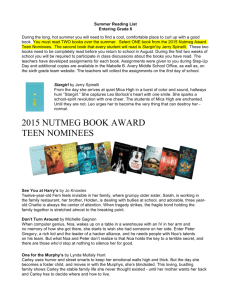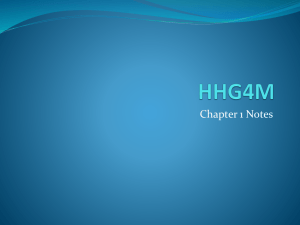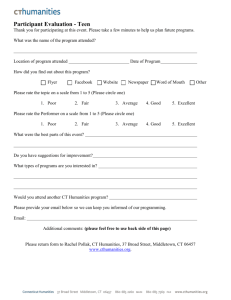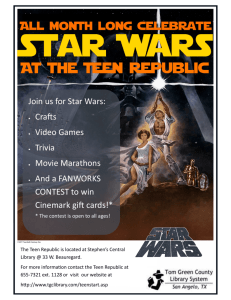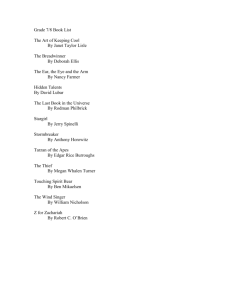Stargirls, Stray Dogs, Freaks, and Nails: Person vs. Society Conflicts
advertisement
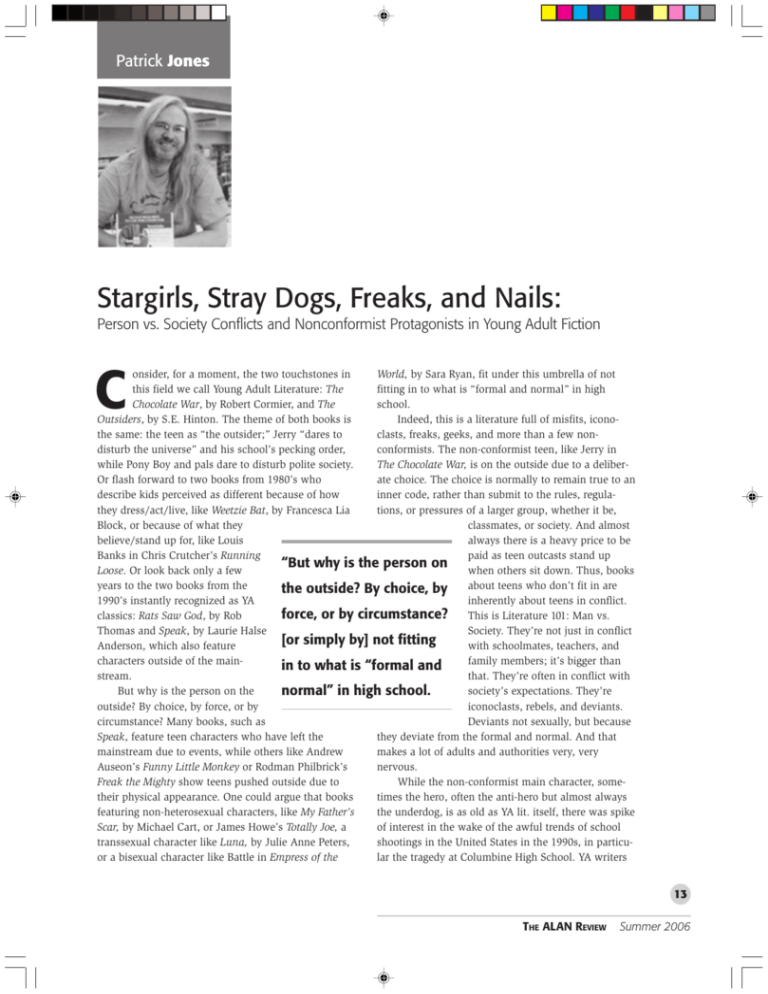
Patrick Jones Stargirls, Stray Dogs, Freaks, and Nails: Person vs. Society Conflicts and Nonconformist Protagonists in Young Adult Fiction C World, by Sara Ryan, fit under this umbrella of not onsider, for a moment, the two touchstones in this field we call Young Adult Literature: The fitting in to what is “formal and normal” in high Chocolate War, by Robert Cormier, and The school. Outsiders, by S.E. Hinton. The theme of both books is Indeed, this is a literature full of misfits, icono­ the same: the teen as “the outsider;” Jerry “dares to clasts, freaks, geeks, and more than a few non­ disturb the universe” and his school’s pecking order, conformists. The non-conformist teen, like Jerry in while Pony Boy and pals dare to disturb polite society. The Chocolate War, is on the outside due to a deliber­ Or flash forward to two books from 1980’s who ate choice. The choice is normally to remain true to an describe kids perceived as different because of how inner code, rather than submit to the rules, regula­ they dress/act/live, like Weetzie Bat, by Francesca Lia tions, or pressures of a larger group, whether it be, Block, or because of what they classmates, or society. And almost believe/stand up for, like Louis always there is a heavy price to be Banks in Chris Crutcher’s Running paid as teen outcasts stand up “But why is the person on when others sit down. Thus, books Loose. Or look back only a few years to the two books from the about teens who don’t fit in are the outside? By choice, by 1990’s instantly recognized as YA inherently about teens in conflict. force, or by circumstance? This is Literature 101: Man vs. classics: Rats Saw God, by Rob Thomas and Speak, by Laurie Halse Society. They’re not just in conflict [or simply by] not fitting Anderson, which also feature with schoolmates, teachers, and characters outside of the main­ family members; it’s bigger than in to what is “formal and stream. that. They’re often in conflict with But why is the person on the society’s expectations. They’re normal” in high school. outside? By choice, by force, or by iconoclasts, rebels, and deviants. circumstance? Many books, such as Deviants not sexually, but because Speak, feature teen characters who have left the they deviate from the formal and normal. And that mainstream due to events, while others like Andrew makes a lot of adults and authorities very, very Auseon’s Funny Little Monkey or Rodman Philbrick’s nervous. Freak the Mighty show teens pushed outside due to While the non-conformist main character, some­ their physical appearance. One could argue that books times the hero, often the anti-hero but almost always featuring non-heterosexual characters, like My Father’s the underdog, is as old as YA lit. itself, there was spike Scar, by Michael Cart, or James Howe’s Totally Joe, a of interest in the wake of the awful trends of school transsexual character like Luna, by Julie Anne Peters, shootings in the United States in the 1990s, in particu­ or a bisexual character like Battle in Empress of the lar the tragedy at Columbine High School. YA writers 13 THE ALAN REVIEW Summer 2006 dug deep trying to figure out why these shootings happened, in part by looking at the shooters, almost all of them cast in their schools on the outside. Don Gallo’s short story collection On the Fringe pulls together stories by some of the best writers in the field to explore how kids get on the fringe and what happens to them there. Some of the writers in the anthology, however, continued to look into the dark hearts and minds of these young people simply asking: how did this happen? Gale Giles’ Shattering Glass, Alex Flinn’s Breaking Point, and The Last Domino, by Adam Meyer, all show outsiders inspired to violence through the need for acceptance from any source. Todd Strasser in Give A Boy a Gun, Walter Dean Myers in Shooter, and Ron Koetge’s Brimstone Journals all asked the question, but found the answers were never easy. But in all books teens who were teased and pushed outside, often due to how they looked or dressed, returned seeking revenge. The penultimate school shooting book was Jim Shepard’s Project X which pulled no punches, nor cutaway from the violence. But one needs to look no further than Stephen King’s early masterpiece Carrie to find the theme of taunted, teased teen seeking revenge in blood. But the literature of the outsider, the iconoclast, the outcast, or the underdog isn’t about revenge, but about acceptance. And that makes perfect sense as acceptance along with independence and identity are three of the key developmental drivers of adolescence. Given that teen fiction reflects teen life and the development drives of independence, acceptance, and identity are foremost in the hearts and minds of most young people, these themes in the literature come as no surprise. Most teen realistic fiction touches on this topic, and there are a slew of titles which put the outsider teen in conflict with a world, family or school that demands conformity. Let’s look in-depth at several recent or breakthrough teen novels which illustrate the theme of the teen outsider. A longer list of titles about teenage outsiders appears as an appen­ dix. With a title like The Misfits, readers know they’re in for a dark ride on the outside of school mainstream society, in this case 7th grade. As was once observed by Kevin in The Wonder Years, it’s not who you are, but who you sit next to at lunch that defines you. In James Howe’s The Misfits, the outsiders find security 14 THE ALAN REVIEW Summer 2006 and acceptance in each other because the rest of the school shuns them. The four seventh graders, who of course call themselves The Gang of Five, are misfits for different reasons: Bob, who tells the story, is too overweight, while Addie is too thin, as well as too smart. Skeezie is called “retard,” while Joe is called “faggot.” But early on, the four realize that “sticks and stones may break our bones, but names will break our spirit.” Despite the taunts all four receive, their friendship makes them stronger, as does their attempts to use the system to fight back. The kids run for student council as the “no name party” pledging to get the school to enact a “no name” day where insults won’t be tolerated. But every push gets a push back as the kids run up against the popular crowd clique and butt heads with the school’s administration. But more importantly, the Misfits need to convince their fellow students at Paintbrush Falls Middle School that namecalling isn’t okay. But it’s not just about politics, but the personal as the characters deal with love, life, death, and issues in the family. Howe also chooses not to tell the story in a conventional way, but using play like dialogue and capturing the “meeting minutes” of their club meetings. Brent Hartinger’s Geography Club similarly explores the group of outsiders who come together; in fact, a club that Howe’s Joe would find empowering. In Geography Club, Russell Middlebrook tries to maintain the neutral position of not being too popular or unpopular. His biggest challenge confronts him daily in the boys’ locker room, where he feels like a soldier on a high school battlefield between straight and gay. He’s seen how his classmates treat the school target, Brian Bund, and no way does he want to endure the kind of physical and psychological torture the enemies inflict on Brian. When Russell meets another Goodkind High School Student in a chat room, he suddenly feels a connection. When he comes face-to-face with “Gay Teen”, Russell realizes the high stakes of keeping who you are a secret. Russell doesn’t have far to fall, but someone like Kevin will plummet. After connecting with Kevin, and coming out to his best girlfriend Min, Russell no longer feels alone. Russell, Kevin, Min and Therse, Min’s girlfriend, agree to meet. They are not kids who would or should be hanging out together according to unwritten high school social laws. Though together they are allies, they are still in enemy territory, and some of them have more status to lose than others. Though Russell comes out to Min, he cannot find the courage to reveal himself to his best friend Gunnar, whose main goal in life is to get a girlfriend. Russell’s fear of Gunnar’s reaction to his sexuality leads him to lend himself as a double dater, going out with the friend of a girl Gunnar likes. Russell lives a double agent life, the straight but shy friend of Gunnar, and the secret gay boyfriend to Kevin. He’s out to some, but not to others. He lives in constant fear of being revealed. But connecting with Kevin also gives him newfound confidence. Kevin encourages Russell to join the baseball team. Hitting a game-winning home run is not the best way to go unnoticed, and when rumors spread that someone wants to start a GayStraight Alliance, the school jocks take their aim at Brian. Russell is on a side now. Defend Brian Bund and become a target, or berate Brian Bund and become more popular? Suddenly whether or not to be out isn’t the toughest choice Russell has to make, as he stands on the brink of deciding what kind of person he is going to be. Some teen characters decide to be different, and then some just are, like Stargirl Caraway, a ukuleleplaying, free spirit in Stargirl by Jerry Spinelli. Spinelli takes a well-worn plot formula—“a stranger comes into town” but plays with it by making the town a normal high school, and the stranger really, really strange. Formerly homeschooled, Stargirl shows up as the new kid at Mica Area High School to wearing pioneer dresses and kimonos to confusion, then outright anger of the school’s “go along get along” population. They don’t know at first how to take her sweetness of spirit, rejection of all that is popular, and utter obviousness at how other reacts to her. Over time, her eccentric behavior, matched with a kindness toward others, and enthusiasm for even the smallest things starts to win over her new schoolmates, culminating in her place on the school’s cheerleading squad. But fish out of water remain that no matter what the uniform, and Stargirl’s comet ride of instant popularity burns out quickly. Not just rejected, Stargirl is humiliated, and then shunned by those who once supported her. The humiliation takes place on a student TV show hosted by average Joe good guy Leo Borlock, who is telling the tale and fascinated by Stargirl. He also might be falling in love with her, not just Stargirl’s snowflake like-uniqueness, but her human strength in the face of adversity. Leo wonders, however, if Stargirl is human— if she’s not a mirage— for she is so odd, so enchanting, and so fleeting. But the questions which Stargirl raises for Leo—forced to choose between the free spirit he loves and the conservative and conventional mind set he’s always embraced—and for readers. Leo’s trying to understand the unknown: the life force that is Stargirl. A similar life force is Egg aka Victoria from Cecil Castellucci’s Boy Proof. Egg demonstrates her outsiderness in appearance—a shaved head and multi­ ring-covered ears—and actions, such as both dominat­ ing and demeaning her fellow Sci Fi Club members. With both her parents connected to the movie indus­ try, Victoria doesn’t feel the need to connect to the normals at her school. In fact, her self-inflicted nickname emerges from the heroine of her favorite science fiction movie with which she’s obsessed with forty plus viewings. What she’s not obsessed with is being popular, fitting in, or dating: her weirdness makes her boy proof. Until Max arrives on the scene and sees some­ thing beyond the hard shell Egg’s made for herself. Finding they have common if odd interests, as well as similar high IQs, Egg leads down her guard to allow Max into the closed set life she’s constructed for herself. The road to romance isn’t easy, in part because it’s unexplored. Egg is so accustomed to both pursuing her own goals (drawing and dreaming) that even friendship is difficult, let alone a relationship. But as she grows closer to Max, Egg starts to realize she’s not an alien on the earth, but a human in as much need of companionship as anyone else. Another girl who just doesn’t fit in at her high school is Rachel in Kathe Koja’s Stray Dog. She’s a smart girl with a mother who would rather she have a social life. “Why should I trade who I am for who they want me to be? So they can pat me on the head and put me in the normal-girl box? I’d rather be alone. I’d rather be a wild dog than jammed in someone’s cage.” With the exception of her English teacher, dogs are the only living things with which Rachel connects, but with an allergic mother, she cannot own one herself. After she finds an animal shelter that accepts her as a volunteer, Rachel finally finds a place she can be 15 THE ALAN REVIEW Summer 2006 herself. She pours all the love she wants to give into a feral dog she names Grrll, and from Grrll she receives the unconditional acceptance she so desperately craves from her parents and peers. Grrll has a growl and a bite, but she’s nonjudgmental, and Rachel identifies with her plight. “She can’t help the way she is.... [a]re we going to kill her for being what she is, what people have made her.?” Rachel wants to save Grrll. If she can save the dogs life, she might have hope for her own. The shelter and English class are Rachel’s retreats. Rachel is a gifted writer, but even that gift doesn’t relieve her of the pressure and judgment she feels from her classmates and family. When her teacher asks her to partner with Griffin, a new student, Rachel reluctantly agrees, even though she’s prejudged him as “Lost Boy,” a category she made up for the outsider kids. Her prejudgments of Griffin are proven wrong when she finally reads his work and they become friends. With her first real friend, an animal who needs her, and her writing, Rachel feels important for the first time. Rachel and Griffin make a plan to save Grrll’s life. But the shelter’s warnings of the fate of a feral dog fell on deaf ears because when Rachel goes to the shelter to tell Grrll the news, that she and Griffin are going to take her home, Rachel is devastated to find that Grrll is gone. Rachel’s rage for the loss of the dog symbolize years of feeling inferior and invisible. Rachel’s violent reaction to the death of Grrll may cause her to lose everything new and good in her life, until a gesture from Griffin, shows her that she’s not alone, and never really was, if she’d stopped growling and let people get closer. Annette Curtis Klause knows a lot about growling, and howling, from her werewolf book Blood and Chocolate, but her new novel Freaks, Alive on the Inside uses a historical setting (the story unfolds in the 1980’s) for a contemporary coming-of-age story about acceptance and identity. As the title announces, this is a book about freaks: human oddities. Like a punch line of a Twilight Zone episode, the main character Abel feels freakish but he’s the normal one in his family, a family of carnival sideshow performers. They all live in Faeryland, where visitors can see perfor­ mances such as “an extravaganza of amazing oddities, mystifying the audience with their uncanny skills, death-defying deeds, and wondrous physiognomy.” 16 THE ALAN REVIEW Summer 2006 His mother has no arms and his father has no legs, but they make it work. As Abel notes in the first line, you know life won’t be easy when your first kiss is with the dog-faced girl. But like any teen, Abel is looking for acceptance from those outside of his family, as well as struggling with who he is: he’s not a freak, so how can he possibly fit in? He takes off to find himself, only to find the world of “normal” people is a lot freakier and much crueler than what he left behind. On the road, Abel joins up with a circus then another freak show, and even lives for awhile in a brothel. Along the way, Abel meets those who help him, those he must help, and the villainous Dr. Mink who views freaks as monsters, not humans with differences. “Freak faggot” is how high school junior Bret Hendricks is greeted by his former friend, now turned bully, Bob Hitchings in my latest novel, Nailed. Bret swims upstream against the tide of his high school where jocks rule, and theater-types like Bret get pushed to the side. Bret’s rejection at school isn’t just from students, but from an ultra-conventional princi­ pal and a disrespectful gym teacher/football coach. But the most pressure to be normal comes not from school but from home, from Bret’s recovering alco­ holic blue-collar father who asks—in the first line of the novel—“Bret, what the hell is wrong with you?” What’s wrong with Bret is he doesn’t fit in, but he’s not sure why and also unsure why it is so important to him. He believes that when he falls in love with the artsy dancer Kylee that all his problems will be solved, only to learn that the worst hurts in life come from those you love the most. Faced with betrayal in love, hostility at home, and scorn at his school, Bret—like the characters in The Misfits— decides to take a stand by running for student council. But his speech with its references to Columbine lead to his suspension and ultimate showdown/ smackdown with Bob Hitchings. In these seven novels and those on the list that follows, the central question of adolescence—Who am I—emerges predominant when the teen characters realize or decide not to be like everyone else. Rather than a thesaurus, the characters in most of these novels define themselves with a dictionary: to be unique, not to be like everyone else. In the mass of conformity that makes up most high schools as the majority rush to Roget’s to look/feel/act like others, characters like Joe, Russell, Stargirl, Egg, Rachel, Abel, and Bret learn the hard way the trust and conse­ quences of the adage “The nail that sticks out farthest gets hammered the hardest.” Patrick Jones is the author of Nailed and Things Change, as well as coauthor of Connecting with Reluctant Teen Readers: Tips, Titles and Tools. A librarian by degree and profession, he has won lifetime achievement awards from the American Library Association, and the Catholic Library Association. Things Change won the YALSA Best book for Reluctant Readers Award. Works Cited Anderson, Laurie Halse. Speak. New York: Farrar, Straus & Giroux, 1999. Auseon, Andrew. Funny Little Monkey. Orlando: Harcourt, 2005. Block, Francesca Lia. Weetzie Bat. New York: Harper & Row, 1989. Cart, Michael. My Father’s Scar. New York: Simon & Schuster Books for Young Readers, 1996. Castellucci, Cecil. Boy Proof. Cambridge: Candlewick Press, 2005. Cormier, Robert. The Chocolate War. New York: Pantheon Books, 1974. Crutcher, Chris. Running Loose. New York: Greenwillow, 1983. Flinn, Alex. Breaking Point. New York: HarperTempest, 2002. Gallo, Don, ed. On the Fringe. New York: Dial Books, 2001. Giles, Gail. Shattering Glass. Brookfield, CT: Roaring Brook Press, 2002. Hartinger, Brent. Geography Club. New York: HarperTempest, 2003. Hinton, S.E. The Outsiders. New York: Viking, 1967. Howe, James. The Misfits. New York: Atheneum Books for Young Readers, 2001. Howe, James. Totally Joe. New York: Atheneum Books for Young Readers, 2005. Jones, Patrick. Nailed. New York: Walker/Bloomsbury, 2006. King, Stephen. Carrie. Garden City, NY: Doubleday, 1974. Klause, Annette Curtis. Freaks, Alive on the Inside. New York: Margaret K. McElderry Books, 2006. Koetge, Ron. Brimstone Journals. Cambridge, Mass.: Candlewick Press, 2001. Koja, Kathe. Stray Dog. New York: Frances Foster Books/Farrar, Straus and Giroux, 2002. Meyer Adam. The Last Domino. New York: G.P. Putnam’s Sons, 2005. Myers, Walter Dean. Shooter. New York: Amistad/ HarperTempest, 2004. Peters, Julie Anne. Luna. New York: Little, Brown, 2004. Philbrick, Rodman. Freak the Mighty. New York: Blue Sky Press, 1993. Ryan, Sara. Empress of the World. New York: Viking, 2001. Shepard, Jim. Project X. New York: Alfred A. Knopf, 2004. Spinelli, Jerry. Stargirl. New York: Knopf, 2000. Strasser. Todd. Give A Boy a Gun. New York: Simon & Schuster Books for Young Readers, 2000. Thomas, Rob. Rats Saw God. New York: Simon & Schuster Books for Young Readers, 1996. APPENDIX: Other outsiders in YA literature: Adoff, Jaime. Names Will Never Hurt Me. New York: Dutton Children’s Books, 2004. Atkins, Catherine. Alt Ed. New York: G.P. Putnam’s Sons, 2003. Bloor, Edward. Tangerine. San Diego: Harcourt Brace, 1997. Brugman, Alyssa. Walking Naked. New York: Delacorte Press, 2004. Crutcher, Chris. Whale talk. New York: Greenwillow Books, 2001. Draper, Sharon M. Battle of Jericho. New York: Atheneum Books for Young Readers, 2003. Flinn, Alex. Fade to Black. New York: HarperTempest, 2005. Foley, Mick. Tietam Brown. New York: Alfred A. Knopf, 2003. Gardner, Graham. Inventing Elliot. New York: Dial Books, 2004. Going, K. L. Fat Kid Rules The World. New York: G.P. Putnam’s Sons, 2003. Hautman, Pete. Sweetblood. New York: Simon & Schuster Books for Young Readers, 2003. Heneghan, James. Hit Squad. Victoria, British Columbia: Orca Book Publishers, 2003. Johnson, Kathleen Jeffrie. Target. Brookfield, CT: Roaring Brook Press, 2003. Juby, Susan. Alice, I Think. New York: HarperTempest, 2003. Koja, Kathe. Buddha Boy. New York: Frances Foster Books, 2003. Konigsburg, E. L. Outcasts of 9 Schuyler Place. New York: Atheneum Books for Young Readers, 2004. Lawrence, Iain. Ghost Boy. New York: Delacorte Press, 2000. Lubar, David. Hidden Talents. New York: TOR, 1999. Luna, Louisa. Brave New Girl. New York: Pocket, 2001. Mackler, Carolyn. The Earth, My Butt, And Other Big, Round Things. Cambridge, MA : Candlewick Press, 2003. Oates, Joyce Carol. Big Mouth & Ugly Girl. New York: HarperTempest, 2003. Peters, Julie Anne. Define Normal. Boston: Little, Brown, 2000. Plum-Ucci, Carol. The Body of Christopher Creed. San Diego: Harcourt, 2000. Plum-Ucci, Carol. What happened to Lani Garver. San Diego: Harcourt, 2002 Shusterman, Neal. The Schwa Was Here. New York: Dutton Children’s Books, 2004. Vizzini, Ned. Be More Chill. New York : Miramax Books/ Hyperion, 2004. Weyn, Suzanne. Bar Code Tattoo. New York: Scholastic, 2004. Wittlinger, Ellen. Razzle. New York: Simon & Schuster Books for Young Readers, 2001. 17 THE ALAN REVIEW Summer 2006
